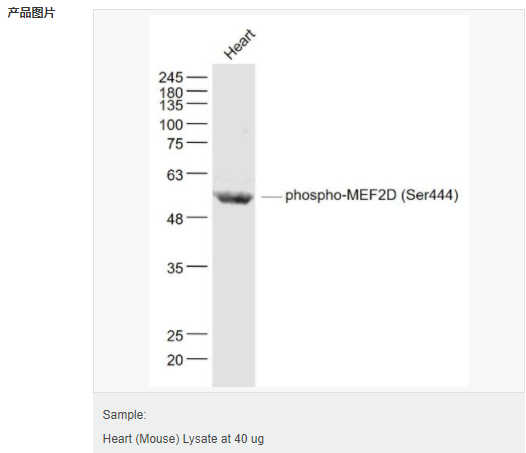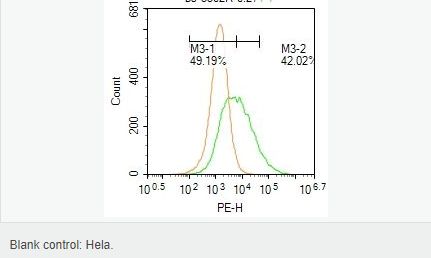

货号
产品规格
售价
备注
BN41107R-100ul
100ul
¥2470.00
交叉反应:Human,Mouse,Rat(predicted:Pig,Cow,Horse,Rabbit) 推荐应用:WB,IHC-P,IHC-F,IF,Flow-Cyt,ELISA
产品描述
| 英文名称 | phospho-MEF2D (Ser444) |
| 中文名称 | 磷酸化肌细胞特异性增强因子2D抗体 |
| 别 名 | MEF2D (phospho S444); p-MEF2D (phospho S444); MEF2D(phospho Ser444); DKFZp686I1536; MADS box transcription factor 2 polypeptide D; Mef2d; MEF2D_HUMAN; myocyte enhancer factor 2D; Myocyte specific enhancer factor 2, polypeptide D; Myocyte specific enhancer factor 2D; myocyte-specific enhancer factor 2D. |
| 产品类型 | 磷酸化抗体 |
| 研究领域 | 心血管 免疫学 发育生物学 染色质和核信号 神经生物学 信号转导 转录调节因子 表观遗传学 |
| 抗体来源 | Rabbit |
| 克隆类型 | Polyclonal |
| 交叉反应 | Human, Mouse, Rat, (predicted: Pig, Cow, Horse, Rabbit, ) |
| 产品应用 | WB=1:500-2000 ELISA=1:5000-10000 IHC-P=1:100-500 IHC-F=1:100-500 Flow-Cyt=0.2ug/test IF=1:100-500 (石蜡切片需做抗原修复) not yet tested in other applications. optimal dilutions/concentrations should be determined by the end user. |
| 分 子 量 | 56kDa |
| 细胞定位 | 细胞核 |
| 性 状 | Liquid |
| 浓 度 | 1mg/ml |
| 免 疫 原 | KLH conjugated Synthesised phosphopeptide derived from human MEF2D around the phosphorylation site of Ser444:PV(p-S)PS |
| 亚 型 | IgG |
| 纯化方法 | affinity purified by Protein A |
| 储 存 液 | 0.01M TBS(pH7.4) with 1% BSA, 0.03% Proclin300 and 50% Glycerol. |
| 保存条件 | Shipped at 4℃. Store at -20 °C for one year. Avoid repeated freeze/thaw cycles. |
| PubMed | PubMed |
| 产品介绍 | MEF2D is a member of the myocyte-specific enhancer factor 2 (MEF2) family of transcription factors. Members of this family are involved in control of muscle and neuronal cell differentiation and development, and are regulated by class II histone deacetylases. Fusions of the encoded protein with Deleted in Azoospermia-Associated Protein 1 (DAZAP1) due to a translocation have been found in an acute lymphoblastic leukemia cell line, suggesting a role in leukemogenesis. The encoded protein may also be involved in Parkinson disease and myotonic dystrophy. Alternative splicing results in multiple transcript variants. Function: Transcriptional activator which binds specifically to the MEF2 element, 5'-YTA[AT](4)TAR-3', found in numerous muscle-specific, growth factor- and stress-induced genes. Mediates cellular functions not only in skeletal and cardiac muscle development, but also in neuronal differentiation and survival. Plays diverse roles in the control of cell growth, survival and apoptosis via p38 MAPK signaling in muscle-specific and/or growth factor-related transcription. Plays a critical role in the regulation of neuronal apoptosis (By similarity). Subunit: Forms a complex with class II HDACs in undifferentiating cells. On myogenic differentiation, HDACs are released into the cytoplasm allowing MEF2s to interact with other proteins for activation. Interacts with HDAC4 (in undifferentiating cells); the interaction translocates MEF2D to nuclear dots. Forms a heterodimer with MEF2A. Subcellular Location: Nucleus. Note=Translocated by HDAC4 to nuclear dots. Post-translational modifications: Phosphorylated on Ser-444 by CDK5 is required for Lys-439 sumoylation and inhibits transcriptional activity. In neurons, enhanced CDK5 activity induced by neurotoxins promotes caspase 3-mediated cleavage leading to neuron apoptosis. Phosphorylation on Ser-180 can be enhanced by EGF. Phosphorylated and activated by CaMK4. Acetylated on Lys-439 by CREBBP. Deacetylated by SIRT1. Sumoylated on Lys-439 with SUMO2 but not SUMO1; which inhibits transcriptional activity and myogenic activity. Desumoylated by SENP3. Proteolytically cleaved in cerebellar granule neurons on several sites by caspase 7 following neurotoxicity. Preferentially cleaves the CDK5-mediated hyperphosphorylated form which leads to neuron apoptosis and transcriptional inactivation (By similarity). Similarity: Belongs to the MEF2 family. Contains 1 MADS-box domain. Contains 1 Mef2-type DNA-binding domain. SWISS: Q14814 Gene ID: 4209 Database links: Entrez Gene: 4209 Human Entrez Gene: 17261 Mouse Omim: 600663 Human SwissProt: Q14814 Human SwissProt: Q63943 Mouse Unigene: 314327 Human Unigene: 28184 Mouse Unigene: 89018 Rat Important Note: This product as supplied is intended for research use only, not for use in human, therapeutic or diagnostic applications. MEF2D及其家族中的其他成员,在细胞存活、分化起着重要的作用。 |

